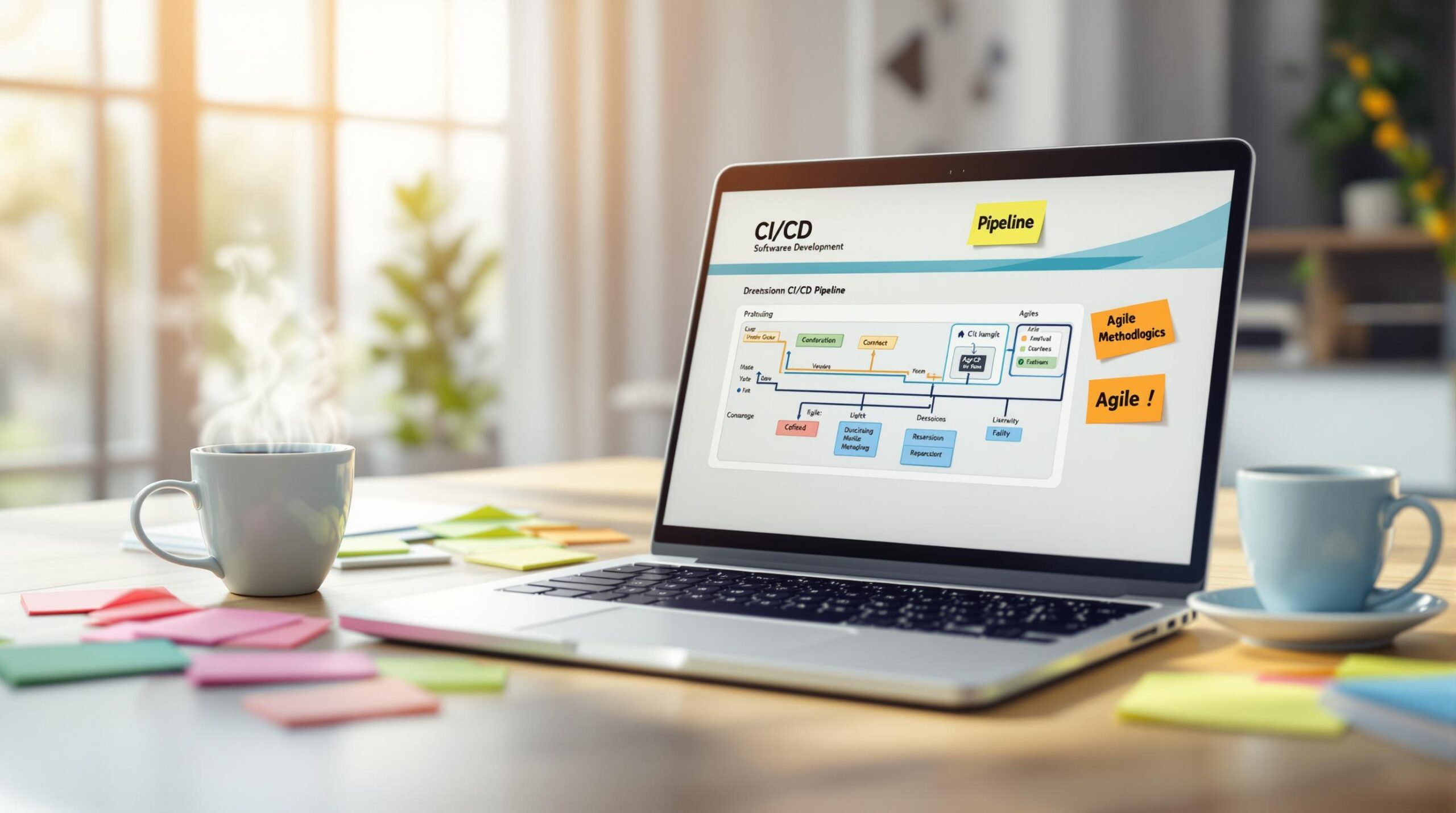Scared of coding? You’re not alone. Many beginners feel overwhelmed by coding, fearing mistakes or thinking they’re not “smart enough.” But here’s the truth: coding is about solving problems step by step, not being a math genius.
Here’s how you can overcome your fear and start coding with confidence:
- Shift Your Mindset: Mistakes are part of learning. Focus on progress, not perfection.
- Learn Logic: Break problems into smaller steps and use tools like flowcharts to map out solutions.
- Start Small: Begin with beginner-friendly languages like Python or Scratch. Build simple projects like calculators or quiz games.
- Use the Right Tools: Platforms like Replit and Sololearn make learning interactive and less intimidating.
With consistent practice and the right approach, you’ll turn coding challenges into opportunities to grow. Ready to start? Let’s break it down step by step.
Logic Skills: The Basics of Coding
Coding logic is like piecing together a puzzle to create something functional and exciting. Let’s look at how you can develop the fundamental thinking skills that make coding feel more approachable.
Breaking Down Problems Into Steps
When tackling a coding problem, breaking it into smaller, actionable steps is key. This process, known as computational thinking, makes complex challenges feel less overwhelming.
For instance, if you’re building a basic calculator app, you could break it down like this: gather user input, validate the input, perform the calculation, and display the result. This step-by-step approach helps beginners avoid the common issue of not knowing where to start. Tools like Scratch and Replit are great for practicing this structured way of thinking through interactive exercises.
Making Logic Visual With Flowcharts
Visual tools can turn abstract coding ideas into clear, easy-to-follow diagrams. Flowcharts, for example, are especially helpful for beginners. Zen Flowchart is one tool that many new coders use to map out program logic before writing any code.
Here’s how flowcharts can improve logical thinking:
| Benefit | How It Helps | Real Application |
|---|---|---|
| Visual Problem Solving | Highlights logical errors before coding | Designing user authentication workflows |
| Clear Process Visualization | Shows step-by-step operations and a big-picture view | Planning app functionality |
| Decision Making | Maps out paths based on conditions | Streamlining a shopping cart checkout |
"Understanding the basics of logic in coding provides a solid foundation for learning more advanced concepts. By mastering step-by-step thinking and problem-solving skills, beginners can more easily grasp complex coding concepts and apply logical thinking to solve more challenging problems" [2][4].
Start with simple tasks, like mapping out a login system. As you gain confidence, you can gradually take on more complicated processes. Visualizing your logic with flowcharts makes intimidating tasks feel more manageable and helps you approach them with clarity.
Debugging is another essential skill that strengthens logical thinking. It teaches you to systematically find and fix errors, reinforcing the idea that mistakes are a normal part of the learning process. This methodical approach boosts confidence and sharpens your problem-solving abilities.
With these foundational logic skills in place, you’re ready to dive into actual coding and put them to work.
Starting to Code: Step-by-Step Guide
Starting small and using the right tools can help you turn hesitation into confidence as you see the results of your coding efforts.
Best Programming Languages for Beginners
Choosing the right programming language can make learning to code much easier. Python is a popular choice for beginners because of its simple and readable syntax. JavaScript is great for those interested in web development, offering instant visual results through browsers. For younger learners or complete beginners, Scratch uses a drag-and-drop interface to introduce coding concepts visually [1].
| Language | Best For | Key Advantage |
|---|---|---|
| Python | General programming | Easy-to-read syntax |
| JavaScript | Web development | Immediate browser feedback |
| Scratch | Visual learning | Simple drag-and-drop interface |
Small Projects to Start With
- Calculator Application: Build a basic calculator to learn about variables, user input, and arithmetic operations. Start simple with addition and subtraction, then move on to multiplication and division.
- Temperature Converter: Create a tool to convert Celsius to Fahrenheit. This project helps you practice formulas, data types, and user interface basics.
- Quiz Game: Develop a multiple-choice quiz game with score tracking. This is a great way to practice using conditional statements, loops, and data structures.
Online Tools for Practice
Replit is an excellent platform for beginners. It lets you write, test, and debug code in a user-friendly environment, perfect for experimenting with your first projects. For a more structured approach, KodNest offers a mix of theory, hands-on projects, and mentorship to help you build coding skills step by step.
"Using interactive platforms like Replit provides a supportive environment for learning and practicing coding skills, making it easier for beginners to start coding without feeling overwhelmed" [1][3].
With these languages, projects, and tools, you can start building a steady learning routine and track your progress as you go.
Building a Learning Mindset
A positive approach to learning can turn coding challenges into opportunities for growth. By shifting your perspective on mistakes and keeping track of your progress, you can build confidence and improve your skills over time.
Fixing Errors and Finding Solutions
It’s normal for beginners to fear making mistakes, but learning to handle errors methodically can transform them into learning moments. As Microsoft’s Logic Course instructor team puts it, "Learning to program means learning how to solve problems using code" [6]. Here’s a simple framework to tackle coding errors:
| Step | What to Do | Why It Helps |
|---|---|---|
| Break Down | Split the error into smaller parts | Simplifies complex issues |
| Debug | Use debugging tools | Pinpoints the problem |
| Research | Look up documentation or reliable sources | Provides tested solutions |
| Test | Apply fixes gradually | Confirms the solution works |
Platforms like LeetCode and HackerRank offer instant feedback on your code, making it easier to identify and learn from mistakes [2]. Also, taking short breaks can help you return with a clearer mindset and fresh ideas.
Once you’ve addressed errors, keeping track of your progress will help you stay motivated and recognize how far you’ve come.
Tracking Your Progress
A coding journal can be a great tool for monitoring your development:
| Milestone | What to Record | Why It Matters |
|---|---|---|
| Daily Practice | Time spent coding, new concepts | Builds consistency |
| Project Completion | Features built, obstacles overcome | Celebrates achievements |
| Error Fixes | Problems solved, solutions applied | Strengthens problem-solving skills |
Platforms like AlgoCademy provide structured learning paths with clear goals, which pair well with a coding journal to document your milestones and growth [2].
"Using interactive platforms provides a supportive environment for learning and practicing coding skills, making it easier for beginners to start coding without feeling overwhelmed" [1][3].
Progress might not always follow a straight path – some topics may come easily, while others take longer to grasp. Focus on steady practice rather than perfection. Joining coding communities or teaming up with a coding buddy can also be helpful. Seeing others tackle challenges reminds you that struggles are temporary and part of the process.
sbb-itb-f454395
Making Your Learning Schedule
A structured learning plan can help you stay on track and avoid feeling overwhelmed – something many new coders struggle with. A good schedule not only keeps you organized but also boosts your confidence as you see steady progress.
Setting Clear Learning Goals
Break big coding topics into smaller, weekly goals using SMART criteria: Specific, Measurable, Achievable, Relevant, and Time-bound. Here’s an example to get you started:
| Time Period | Goal | Success Metric |
|---|---|---|
| Week 1 | Learn Python basics: variables and data types | Complete 5 practice exercises with 80% accuracy |
Start with the basics and gradually tackle more complex topics. This step-by-step method helps you build confidence by achieving small wins, making harder concepts feel less daunting.
Daily Practice and Learning Tools
Consistency is key. A focused 30-minute daily session often beats sporadic hours of cramming. Here’s a simple structure to guide your practice:
| Time Block | Activity | Tool |
|---|---|---|
| Daily Practice | Review concepts and solve exercises | Documentation/Replit |
| Project Work | Apply what you’ve learned | VS Code/GitHub |
To keep up the momentum:
- Choose a consistent time each day when you’re most focused.
- Set up a quiet, distraction-free workspace.
- Explore beginner-friendly tools like Scratch for visual learning.
Don’t rush through challenging topics – spend extra time where needed. The aim is steady improvement, not speed. While consistency is important, leave some room in your schedule for unexpected events. Regular practice, even in small doses, will help you grow your skills and confidence over time.
Conclusion: Practice Makes Progress
Overcoming the fear of coding starts with consistent practice and tackling challenges step by step. At its core, coding relies on logical thinking. Tools like flowcharts can break down complex problems into simpler parts, and platforms like AlgoCademy offer structured, hands-on learning paths to help build confidence.
Here’s a look at how you can progress as a coder:
| Learning Stage | Focus Area | Tool/Platform |
|---|---|---|
| Foundation | Basic Logic | Scratch, Flowcharts |
| Practice | Simple Projects | Replit |
| Growth | Coding Challenges | LeetCode, HackerRank |
These resources provide immediate feedback and structured environments, making it easier to stay consistent. As you refine your debugging and problem-solving strategies, your confidence will naturally grow [2]. This shift in mindset turns obstacles into opportunities [1].
"Regular and consistent practice helps in developing logical thinking and problem-solving skills, which are critical for coding" [2].
Progress in coding doesn’t follow a straight line. Some concepts will click quickly, while others might take more time and effort. With persistence and the right mindset, you can shift from fearing coding to enjoying the process of solving problems and building creative solutions. Focus on steady improvement and embrace the challenges – they’re the key to turning coding into a powerful tool for creation.
FAQs
How do absolute beginners learn coding?
Learning to code can seem intimidating, but following a clear plan can make it manageable. Combining structured lessons with hands-on practice works best for most beginners.
Here are some helpful tools and platforms to get started:
| Learning Component | Platform/Tool | Why It Helps |
|---|---|---|
| Interactive Courses | freeCodeCamp, Codecademy | Offers guided lessons with feedback |
| Visual Programming | Scratch | Teaches coding concepts without syntax |
| Problem-Solving | Microsoft Logic Course (edX) | Builds logical thinking skills |
| Practice Environment | Sololearn, Replit | Provides a space to test and learn |
Start by mastering the basics – like variables, loops, and conditionals – before moving on to bigger projects. Regular practice and solving small coding challenges are key to building confidence.
"Taking introductory coding courses, learning the basics, joining forums and communities, using online code playgrounds, and developing logical thinking skills through regular practice and problem-solving exercises are essential steps for beginners" [1][3].
Resources like Khan Academy offer structured paths for beginners, while online coding communities can be great places to ask questions and learn from others. Python is often recommended as a starting language because of its straightforward syntax and readability. [5]





